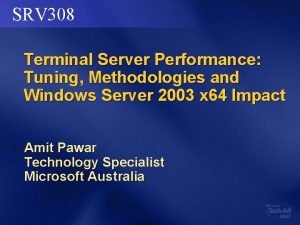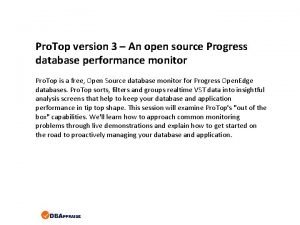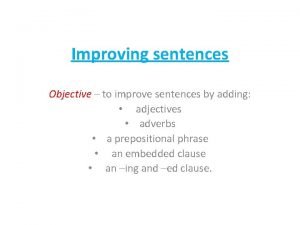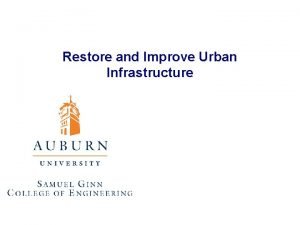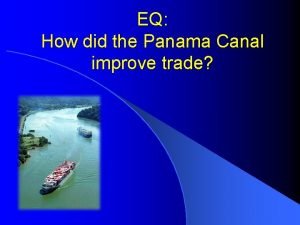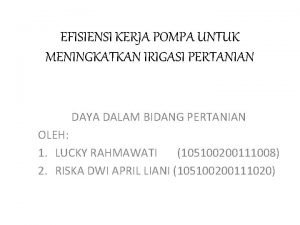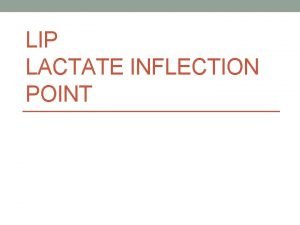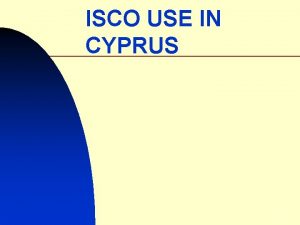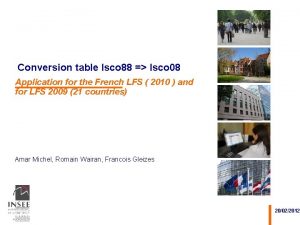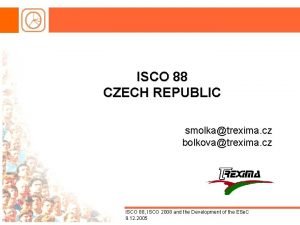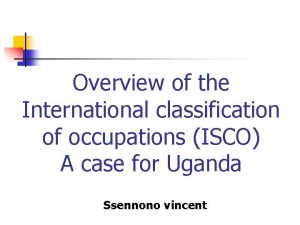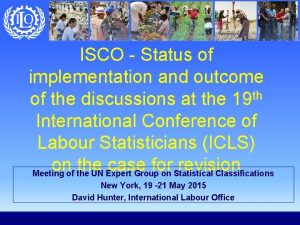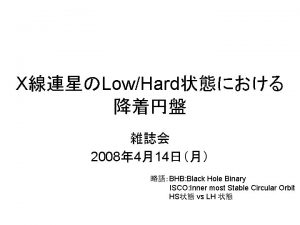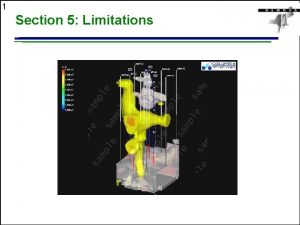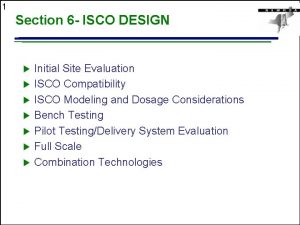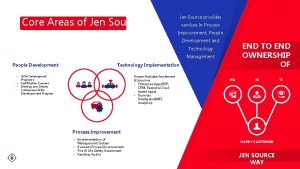How to Improve ISCO Performance in Source Areas






































- Slides: 38

How to Improve ISCO Performance in Source Areas BEPA - NEPA Environmental Professionals' Conference Birmingham, AL April 4, 2018 Patrick Hicks, Ph. D. Technical Sales Manager SE Peroxy. Chem

Presentation Overview • ISCO Fundamentals • Critical Aspects to Apply ISCO - Chemistry – Reagent dose – Establishing contact in the subsurface – Monitoring Program • Conclusions 2

ISCO FUNDAMENTALS

Environmental Remediation 101 Contaminant Mass Distribution hemi logy Geoc ogeo Hydr stry In Situ Remediation 4

What is ISCO • In Situ Chemical Oxidation (ISCO) – Transform/degrade contamination in place in the subsurface Massive supply of thermodynamically powerful electron acceptors • Addition of chemicals that take electrons from, or oxidizing, contaminants of concern (COCs) • Reductive (electron donating) and nucleophilic pathways are also present with certain technologies – Allows for treatment of multiple types of contaminants – Technology and activation method specific 5

Reaction Pathways • Oxidative – Electrons are taken from contaminants CO 2 • Reductive – Electrons are donated to the contaminants CH 4 • Nucleophilic – Substitution reaction (electron neutral) 6

Common ISCO Technologies • Common ISCO Technologies – – Activated Persulfate Hydrogen Peroxide Permanganate Ozone 7

Hydrogen Peroxide: Key Characteristics • Often referred: – Fenton’s reagent – Catalyzed hydrogen peroxide – Catalyzed H 2 O 2 Propagations • Based on the decomposition of hydrogen peroxide • Characteristics – Capable of degrading most types of contamination – Relatively inexpensive – Forms oxidants, reductants, and nucleophiles – Decomposes to water and oxygen – Persistence: Days to Weeks • Common Issues – Sensitive to subsurface conditions (can decompose in minutes or persist for days) • If an issue, can impede successful distribution – Gas and heat evolution • Limits injection concentration – Hydroxyl radical can be scavenged by naturally occurring carbonates • Current State – Stability • Stabilizers can be added with limited success – Gases can be captured – Injection concentration often limited to less than 12 percent hydrogen peroxide. 8

Permanganate: Key Characteristics • Based on the reaction of permanganate forming manganese dioxide – Direct oxidative pathway • Characteristics – Reactive with: • Chlorinated ethenes (TCE, PCE, etc), some PAHs, etc • Little to no reaction with many other compounds (chloromethanes, chloroethanes, benzene, MTBE, etc) – Kinetically aggressive reactions with chloroethenes – Sodium or potassium and manganese dioxide are typical end products – Potential persistence: months or longer • Common Issues – Reactive in the field with a limited suite of compounds – Field solubility: • Potassium permanganate ~30 g/L • Sodium permanganate ~400 g/L (typical application < 200 g/L) – Manganese dioxide is a solid – Very stable, can persist for months to years, if oxidant demand is met • Current State – Used to treat chlorinated ethene and some PAH sites. 9

Activated Persulfate: Key Characteristics • Based on the decomposition • Activation of the persulfate anion – Alkaline, hydrogen peroxide, • Characteristics – Most kinetically viable and powerful reactions depend upon activation. – Depending upon activation method- capable of degrading most types of contamination • Can form oxidants, reductants, and nucleophiles – Relatively inexpensive – Sodium and sulfate are typical end products – Persistence: Weeks to Months and heat form oxidative, reductive and nucleophilic pathways – Iron forms oxidative only pathway • Common Issues – Generates acid during decomposition • Current State – If exceeding soils natural buffering capacity, alkaline activation is used to off set acid formation – Typically injected at 50 -250 g/L 10

ISCO DESIGN AND IMPLEMENTATION

Key to Success for Field Applications • Highly efficient reactions are known to take place on the laboratory scale – 100% contact between ISCO and contamination • Scale up to the field: ISCO works by establishing contact between a sufficient mass of activated oxidant with the contaminant mass in the subsurface, for a sufficient time. • Critical Aspects • Oxidant Mass • Establishing Contact • Monitoring Program 12

Design Failures • Most likely due to: – Not enough material was used – Not enough material was placed in the correct location – Improper design Approaches for each of these topics for ISCO will be discussed Tacoma Narrows Bridge prior to its collapse 13

OXIDANT MASS

Design of Field Applications Developing a sufficient mass of oxidant: 1. Target demand a) Contaminant type b) Mass in GW, on soil, or in NAPL phases 2. Non-target demand 3. Uncertainties and variability a) b) c) d) Target demand Non-target demand Contaminant distribution Desorption or back diffusion rates of mass sorbed to soil 4. Remedial goals 15

Calculating Proper Oxidant Dose • Basic formula-Oxidant Mass: [(CMSoil + CMGW + CMNAPL) x Ratio + SOD * Soil Mass] x S. F. Where: – – CMSoil CMGW CMNAPL Ratio – SOD – S. F. = Contaminant mass in the soil phase = Contaminant mass in the groundwater phase = Contaminant mass in the NAPL phase = Degradation or stoichiometric ratio of oxidant needed to treat a unit mass of contaminant = Soil Oxidant Demand (g Oxidant per Kg Soil) = Safety Factor 16

Oxidant Mass: Detailed Assumptions [(CMSoil + CMGW + CMNAPL) x Ratio + SOD x Soil Mass] x S. F. • Average or maximum concentrations? • NAPL • Stoichiometric vs empirical ratios ? • Soil Density? • Non-target demand? Soil Type Bulk Density Range (lbs/ft 3) lower upper variation compacted sandy loam 100 125 25% compacted clay loam 90 110 22% compacted glacial till 120 140 17% undisturbed subsurface soil 90 140 56% Hydrogen Peroxide has potentially significant auto-decomposition mechanism that has to be considered • Safety Factor? – Conservative design, unknowns, variables, and uncertainties 17

Math is great, but…. • First cut design use estimates for: – Target Demand – Non-target demand – Uncertainties • Other ways of determining dose: • Thermodynamics (something will happen) vs kinetics (how quickly something will happen) – Minimum injection concentrations: • Approximately 40 to 50 g/L – Minimum concentrations in the subsurface: • Approximately 20 to 30 g/L – Total oxidant demand tests – Detailed bench tests 18

High COC Source Mass • Technology specific • ISCO: • Oxidant mass • Injection volume • Flexible approach • Injection network density • Multiple applications • Robust monitoring program • If needed: Bring the hammer But careful with hydrogen peroxide 19

ESTABLISHING CONTACT

Establishing Contact • Common strategies to establish contact between the oxidant and the contamination in the subsurface – In situ shallow and deep soil mixing – Amendments to excavations – In situ injection strategies 21

In Situ Mixing/Stabilization • Divide site into cells (e. g 10’x 10’) and lifts (e. g. 5’) • Goal = homogenous target zone. • Can establish contact even with low permeable soils – Can address matrix back diffusion issues – Function of mixing time per cell • Keys to implementation: – Correct dose and uniformity of blend within each cell – Balance % pore volume mixed for contact versus post mixing compaction requirements Base of excavation can also be mixed • 22

In Situ Soil Blending/Stabilization Conditioning Soil with Lime Thorough Incorporation Courtesy of Exo Tech 23

Injection Strategies • Direct Injection – Injection through injection point either direct push or fixed injection wells. • Recirculation – Injection through injection point coupled with extraction through separate extraction points • Pull/Push – Extract a volume of groundwater from a point, amend with reagents, and reinject into the same point • Flow Down – Inject reagents to let groundwater advection transport the reagents to the target area 24

In Situ Injection 25

Klozur. TM Sodium Persulfate Injection Wells 26

Klozur Injection Well Operation Activated Klozur Reaction with Hydraulic Fluid Injection Process 27

Injection Network • Injection point density • Overlapping design ROIs – Avoid gaps • Accounting for mass outside the target area Design Radius of Influence (ROI) • Distance “on center” • Groundwater velocity (seepage velocity) can distort “circles” – Modified “flow down” strategy: Tighter spacing between points and longer spacing between rows – ROI must account for advection within the time the oxidants are reactive 28

Injection Volume • Reagents have to be distributed Design within subsurface in order to Radius of establish contact – Distribution should be evaluated on pilot test (horizontal and vertical) • Effective pore volume – Portion of the pore volume that is mobile (e. g. 1 to 30%) – Consider injection volume as a percent of the effective pore volume to support ROI calculations Influence (d. ROI) Injection Radius of Influence (i. ROI) • Primary distribution mechanisms include: – Advection from injection – Advection from groundwater flow (velocity) 29

OTHER CONSIDERATIONS

Subdivide the Target Volume • Divide the site into mass or lithogical subsets – Establish contact between sufficient mass of oxidant for the contamination – Method of establishing contact or injection rates, pressures, etc, may change based upon geology • Injection concentration or volume can be varied to deliver appropriate mass of oxidant into each subsection 31

Number of Applications • Wells vs DPT rods? • Many designs utilize a multiple application strategy. Reasons for a multiple application strategy include: – Injection volume and number of applications used to maintain practical reagent injection concentrations – Evaluative (Iterative) approach: Monitoring between applications can be used to refine target area • Diagnostic for highly contaminated areas • Minimizes initial commitment allowing for further site assessment • Optimize events to reduce remediation target volume or troubleshoot areas not responding per design – Injection locations can be staggered between events • Potential issues with a multiple application strategy – Preferential treatment of non-target demand changes partitioning between soil and groundwater – interim results – Partial treatment of COCs 32

MONITORING PROGRAM

Monitoring Programs • • Critical aspect to ISCO design • – Allow time: • • • Objectives – Progress toward remedial goals – Assessing effectiveness of ISCO application • • Soil ISCO to react Groundwater, soil and NAPL re-equilibrate Can have biotic activity following ISCO – Minimum 2 -3 months post application recommended – Multiple monitoring events recommended to determine new equilibrium Monitoring Phase – Soil and groundwater typical – Phase monitored may be different for each objective – Progress of ISCO best measured by total mass reduced (GW mass plus Soil mass) – HRSC as additional line of evidence on mass reduction considering variability in soil analysis. Frequency • Parameters – Contaminant – Residual oxidant – Geochemical parameters • DO, temperature, conductivity, p. H, ORP – Others, as needed – Discrete/grab – Composite 34

Design of Field Applications • What does the data actually represent – Groundwater velocity and direction – Active reagent solution – Equilibrium Slight shift in GW direction Flat GW gradients sometimes reverse ISCO Event Active Oxidant Soil – GW equilibration 35

SUMMARY

Recommended Practices • Technologies based on ISCO materials have been proven to work. – ISCO applied at many thousands of sites • Recommended practices for application design and monitoring program: – Design • Consider all aspects in determining the proper oxidant mass – Target demand, non-target demand, and variables to be addressed with conservative design or safety factor • Establish sufficient contact between the oxidant and contamination in the subsurface – – Distribution through injection event Distribution effects from groundwater/seepage velocity • Consider impacts of groundwater/seepage velocity • Flexible approach as needed – More is learned with each site visit • Successful implementation of the design: – – Experienced implementation team Proper H&S – Monitoring • • • Develop monitoring program that fits site needs and requirements Wait for new equilibrium to be established between soil and GW for final GW results Emphasis on soil data. Sufficient grab samples or composite samples Measuring Foc to understand relationship of partitioning between soil and groundwater Use of high resolution data to assess site 37

How to Improve ISCO Performance in Source Areas Comments and Questions are Welcome! Patrick Hicks, Ph. D. Technical Sales Manager, Southeast Region Peroxy. Chem Soil & Groundwater Remediation Phone: 919 280 7962 patrick. hicks@peroxychem. com www. peroxychem. com/remediation Technology that really Works 38
 Isco 08:3213
Isco 08:3213 How to improve organisational performance
How to improve organisational performance Decision making to improve marketing performance
Decision making to improve marketing performance Improve terminal server performance
Improve terminal server performance Openedge database monitoring
Openedge database monitoring Performance levels
Performance levels Jcids process
Jcids process Performance levels
Performance levels Governments can sometimes improve market outcomes
Governments can sometimes improve market outcomes How does debt factoring improve cash flow
How does debt factoring improve cash flow Open source assessment
Open source assessment Verb to noun suffix
Verb to noun suffix What is the difference between spirituality and religion
What is the difference between spirituality and religion Boring sentences to improve
Boring sentences to improve Protect, promote, and improve the health of all people
Protect, promote, and improve the health of all people Settings for a story
Settings for a story Accurate cutting facilitates sewing and improve garment
Accurate cutting facilitates sewing and improve garment Improve your tomorrow
Improve your tomorrow Restore and improve urban infrastructure
Restore and improve urban infrastructure How did the panama canal improve trade
How did the panama canal improve trade Army attributes and competencies
Army attributes and competencies Quotes about measurement and improvement
Quotes about measurement and improvement You can t manage what you can t measure
You can t manage what you can t measure Escore de padua
Escore de padua Efisiensi pompa
Efisiensi pompa How to improve psychomotor skills
How to improve psychomotor skills Lactate inflection point graph
Lactate inflection point graph Dialog reflektif plc
Dialog reflektif plc How did john smith improve conditions in jamestown
How did john smith improve conditions in jamestown Walk ikinci hali
Walk ikinci hali How to improve personality
How to improve personality How to improve cash flow gcse business
How to improve cash flow gcse business Gearing ratios
Gearing ratios Overhead clear drills
Overhead clear drills How did the hongwu emperor improve life for the peasants?
How did the hongwu emperor improve life for the peasants? Kiss method keep, improve start stop
Kiss method keep, improve start stop If you can't measure it you can't manage it
If you can't measure it you can't manage it Project charter voorbeeld
Project charter voorbeeld The universe is sacred you cannot improve it
The universe is sacred you cannot improve it



